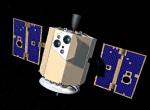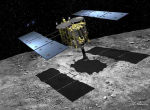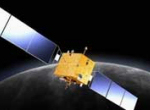Missions to asteroids
Galileo
 |
Launched on 18 October 1989, NASA's Galileo spacecraft set a course for Jupiter and its moons. On the way to the Jovian system, Galileo flew past and imaged two asteroids: first, the main-belt asteroid Gaspra in 1991, and then asteroid Ida two years later in 1993. From this flyby Ida was found to have a small satellite, later named Dactyl.
Before deliberately crashing into Jupiter on 21 September 2003, the probe explored the Jovian atmosphere and observed evidence of subsurface water and volcanic activity on a handful of the gas planet's moons. Notably, Galileo observed the impact caused by comet Shoemaker-Levy 9 crashing into Jupiter in July 1994.
Clementine
 |
NASA's Clementine spacecraft was launched on 25 January 1994. After mapping the surface of our Moon, Clementine intended to move on to making scientific observations of near-Earth asteroid Geographos, to explore the asteroid's surface features and physical properties.
However, after Clementine successfully completed the lunar portion of the mission and left its orbit around the Moon in May 1994, one of its onboard computers malfunctioned, causing a thruster to fire and use up all the spacecraft's fuel. It was not possible to continue the mission to Geographos, although Clementine remained in space to test how its components reacted to the harsh environment until the end of its mission.
NEAR-Shoemaker (Near Earth Asteroid Rendezvous)
 |
NEAR-Shoemaker was launched on 17 February 1996 by NASA. This spacecraft carried out the first long-term study of an asteroid at close quarters, exploring the mass, structure, geology, composition, and gravity of nearby asteroid Eros.
On 27 June 1997 NEAR closely flew past asteroid Mathilde, coming within 1212 km of the asteroid's surface. On 14 February 2000, NEAR settled into orbit around its primary target Eros, and touched down on the asteroid's surface in February 2001, transmitting close-up images as it descended.
Cassini-Huygens
 |
On 15 October 1997, the NASA/ESA/ASI Cassini-Huygens mission to Saturn and its moons was launched. On 23 January 2000, while passing through the asteroid belt en route to Saturn, the spacecraft performed a flyby of asteroid Masursky, taking numerous photographs and estimating the asteroid's size.
Deep Space 1
 |
NASA's Deep Space 1, launched on 24 October 1998, aimed to test various advanced technologies in space. On 29 July 1999, Deep Space 1 flew by asteroid Braille, coming within just 26 km of its surface and managing to make a large number of observations which have added to our knowledge of asteroids.
The mission was extended to perform a successful flyby of Comet Borrelly in September 2001, again yielding valuable images and data that were not a part of the initial mission requirements. The mission was retired on 18 December 2001.
Stardust and Stardust-NExT
 |
Launched on 7 February 1999, NASA's Stardust mission swung past asteroid Annefrank on 2 November 2002 en route to its primary target, Comet Wild 2, which the spacecraft encountered in January 2004. Samples from Wild 2 were also returned to Earth via a capsule in 2006, making Stardust the first comet sample return mission of its kind.
While the flyby of asteroid Annefrank was primarily used as a way to test Stardust's systems and capabilities leading up to its planned rendezvous with Wild 2, images obtained during the flyby returned interesting data, showing a small and heavily cratered rocky body that was darker and around twice as large as expected.
Following Stardust's success the mission was extended under the new moniker of Stardust-NExT (New Exploration of Tempel 1) [, with the spacecraft being directed to intercept and image a second comet, Tempel 1 – a task it successfully completed in early 2011.
Hayabusa (formerly Muses-C)
 |
Hayabusa, translated as "peregrine falcon", was launched on 9 May 2003 by the Japan Aerospace Exploration Agency (JAXA). The spacecraft, formerly known as Mu Space Engineering Spacecraft C (MUSES-C), headed to asteroid Itokawa, meeting it on 12 September 2005 and studying its physical characteristics and properties. Hayabusa went on to land on the asteroid in November 2005, staying until April 2007 before returning to Earth in June 2010 with samples from Ikotawa's surface.
Deep Impact Extended Investigation (DIXI)/EPOXI
 |
Launched on 12 January 2005, Deep Impact was a NASA probe designed to study the composition of Comet Tempel 1. It successfully completed its mission in July 2005 after launching an impactor at the comet's nucleus, producing a cloud of debris and making it the first mission to eject material from a comet's surface. Following this, the Deep Impact probe was repurposed in 2007 to explore more comets and also extrasolar planets under the new combined moniker of EPOXI (Extrasolar Planet Observation and Deep Impact Extended Investigation).
In 2011, EPOXI was directed towards asteroid 2002 GT, which it would reach in 2020. However, before EPOXI could reach the asteroid it suffered a loss of communication with Earth, bringing an end to the mission in September 2013.
Rosetta
 |
ESA's Rosetta was launched on 2 March 2004, beginning a 10-year-long trek towards Comet 67P/Churyumov-Gerasimenko. On its way the spacecraft performed two asteroid flybys: Steins in September 2008, and Lutetia in July 2010.
Rosetta continuously monitored Steins as it approached, passing by on 5 September 2008. This flyby showed that Steins was diamond-shaped, with dozens of craters and some prominent severe impact scars. Steins is now thought to be part of a larger object that broke apart as it was struck by other objects.
Rosetta's flyby of Lutetia a couple of years later on 10 July 2010 revealed the asteroid's complex history, putting bounds on its mass, volume, density, composition, age, surface appearance, and more.
Rosetta reached its primary target, Comet 67P/Churyumov-Gerasimenko, on 6 August 2014, settling into an orbit around the comet to map its surface before sending a lander, Philae, down onto its surface in November 2014. The mission will continue with Rosetta escorting the comet through perihelion in August 2015, monitoring the changes in the comet as it journeys towards and then away from the Sun.
Dawn
 |
NASA's Dawn mission, launched on 27 September 2007, aims to explore two of the largest rocky bodies (protoplanets) to remain intact since their formation: Vesta and Ceres.
From July 2011 to September 2012 Dawn was in orbit around Vesta, gathering thousands of images and making measurements – leading to early results about the composition, topography, and geological morphology of the rocky body. It then continued on towards its second target, Ceres, which it is scheduled to reach in spring 2015.
Chang'e 2
 |
After launch on 1 October 2010, Chang'e 2 entered lunar orbit, exploring its surface in preparation for Chang'e 3, which landed on the Moon in December 2013. After this phase of its mission Chang'e 2 headed towards the L2 Lagrange point, which it reached in August 2011. In April 2012, the spacecraft was sent towards asteroid Toutatis on an extended mission, completing a flyby of Toutatis in December 2012. Chang'e 2 is now more than 70 million km from Earth and is still considered "alive" – operators continue to monitor how its systems perform in deep space.
Hayabusa 2
 |
An extension of the Japan Aerospace Exploration Agency's (JAXA) previous Hayabusa mission, Hayabusa 2 is an asteroid exploration and sample return mission scheduled for launch in 2014. Its target is a small asteroid known as 1999 JU3, which the spacecraft should reach in 2018. After orbiting and studying the asteroid for a year and a half, Hayabusa 2 will send a lander to 1999 JU3's surface to collect samples, which will be returned to Earth in late 2020.
OSIRIS-REx
 |
OSIRIS-REx (the Origins Spectral Interpretation Resource Identification Security - Regolith Explorer) is a NASA mission scheduled for launch in the autumn of 2016. This mission will closely study the orbital characteristics and surface features of asteroid Bennu, which it will reach in 2018. OSIRIS-Rex will also collect and return samples from the asteroid's surface.
Asteroid Redirect Mission (ARM)
 |
As part of an initiative to further asteroid exploration, NASA is considering a robotic spacecraft (launch in 2019) to an as-yet-undetermined target asteroid. Two concepts are currently under consideration: the first being to capture a small asteroid in space, and the second to collect a large boulder-sized sample from a large asteroid. In late 2014 NASA will choose between these concepts and define the mission's design.
